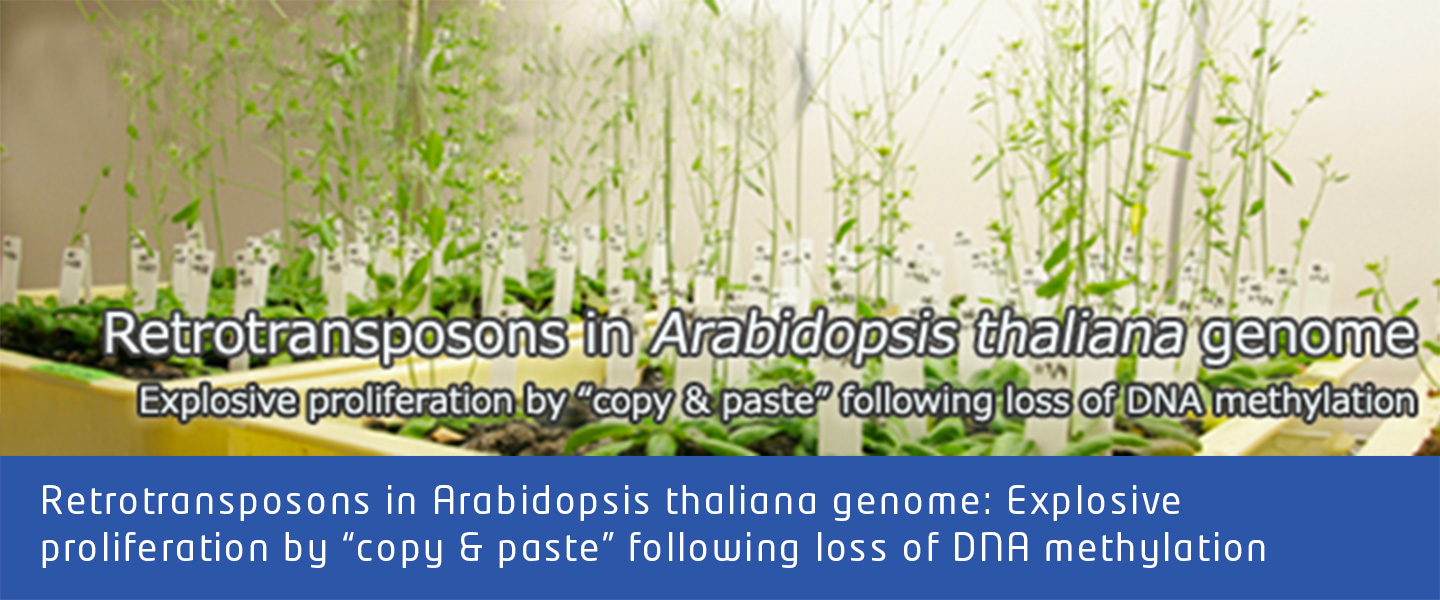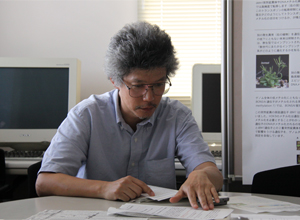Explosive proliferation of retrotransposons by “copy & pasete” following loss of DNA methylation

| Tetsuji KAKUTANI, D. Sc., Professor, and Akie KOBAYASHI, Postdoc, Division of Agricultural Genetics, Department of Integrated Genetics, National Institute of Genetics/ SOKENDAI. |
| Sayuri TSUKAHARA, Ph.D Student Department of Genetics, SOKENDAI. (Graduate University for Advanced Studies) |
Some vertebrates and higher plants have a huge genome. The genomic sequencing of several species including human has revealed that a large portion of such a huge genome does not correspond to genes. Much of such a “useless” part of the genome are composed of sequences called transposons. That is a source of recent excitement of Professor Tetsuji KAKUTANI and his colleagues, Dr. Akie Kobayashi and Ms. Sayuri Tsukahara, a second-year PhD student. By analyzing mutant Arabidopsis thaliana with decreased level of cytosine methylation, they discovered proliferation of transposons. Methylation of cytosine is one way to regulate gene expression in the genomes of vertebrates and plants. When cytosine is methylated in upstream of genes, their expressions are very often repressed. In the case of plants, most of the methylated cytosines are found on transposons.

“If methylation is really important for organisms, what disadvantages can be induced when the methylation is lost?” wondered Dr. Kakutani, who has been working on the question over a decade by analyzing mutant Arabidopsis thalianawhose methylation level is decreased all over the genome. The mutation induces various types of developmental abnormalities, such as abnormal flower or leaf shapes, sterility, and delay in flowering onset. The recent research achievements by the group started from genetic analyses of a strain with small petals and waved sepals. Since this combination of abnormalities behaved as a monogenic Mendelian trait, the group decided to identify genes responsible for the abnormalities by genetic linkage analysis.
“As a result, we found that a retrotransposon was inserted into a gene (FAS1) and disrupted function of that gene, resulting in the abnormal phenotypes,” says Ms. Tsukahara, who conducted the analyses. Retrotransposons are transposons that can produce RNA from DNA and then reverse-transcribe RNA to produce DNA; that is to say, retrotransposons can transfer copies into the genome by “copy & paste.” By this mechanism, a large number of transposons in the genome are generated. Such an explosive proliferation of transposons influences the evolution and diversity of genomes.

The team also examined if other types of transposons also proliferate in the ddm1 mutant background. The key method is the use of genomic tiling arrays to quantitate amount of specific sequence. “By this method, we could identify three additional classes of retrotransposons that increased the copy number when DNA methylation is lost” says Dr. Kobayashi. Furthermore, they examined transposons in the genome of a natural species closely related to Arabidopsis thaliana and discovered that similar retrotransposon have proliferated relatively recently.
Before their research, no mobile endogenous retrotransposons have been identified in the genome of Arabidopsis thaliana. Ms. Tsukahara is excited to continue the research to examine how this retrotransposon behaves in the genome. This research can result in an important clue to genome evolution.
Dr. Kakutani believes that research into transposon dynamics and methylation functions using Arabidopsis thaliana can lead to a better understanding of similar mechanisms retained in other organisms. The human genome contains many transposons. Abnormalities in methylation are known to result in cancer and other human diseases. Much is expected from future discoveries of new biological mechanisms and paradigms that surpass the plant-animal boundary.
(Interviewed by Naoko Nishimura on Sep. 7, 2009)
Bursts of retrotransposition reproduced in Arabidopsis
Sayuri Tsukahara, Akie Kobayashi, Akira Kawabe, Olivier Mathieu, Asuka Miura, Tetsuji Kakutani, Nature 461, 423-426, 2009. DOI:10.1038/nature08351
Back














